Declare the departure of a carrier (ETO)
Actors | Gate Operator |
|---|---|
Description | As a gate operator, you are responsible for declaring the handled goods/units entering and exiting the terminal. When a transport exits the terminal, the gate operator is responsible for indicating the departure of the carrier for a Full Container Release (IMPORT)" transport order type and for recording the exact quantity of goods that have left the terminal. |
Declare the departure of a carrier
Connected as a Gate operator, click on Transport orders menu in Terminal Park section.
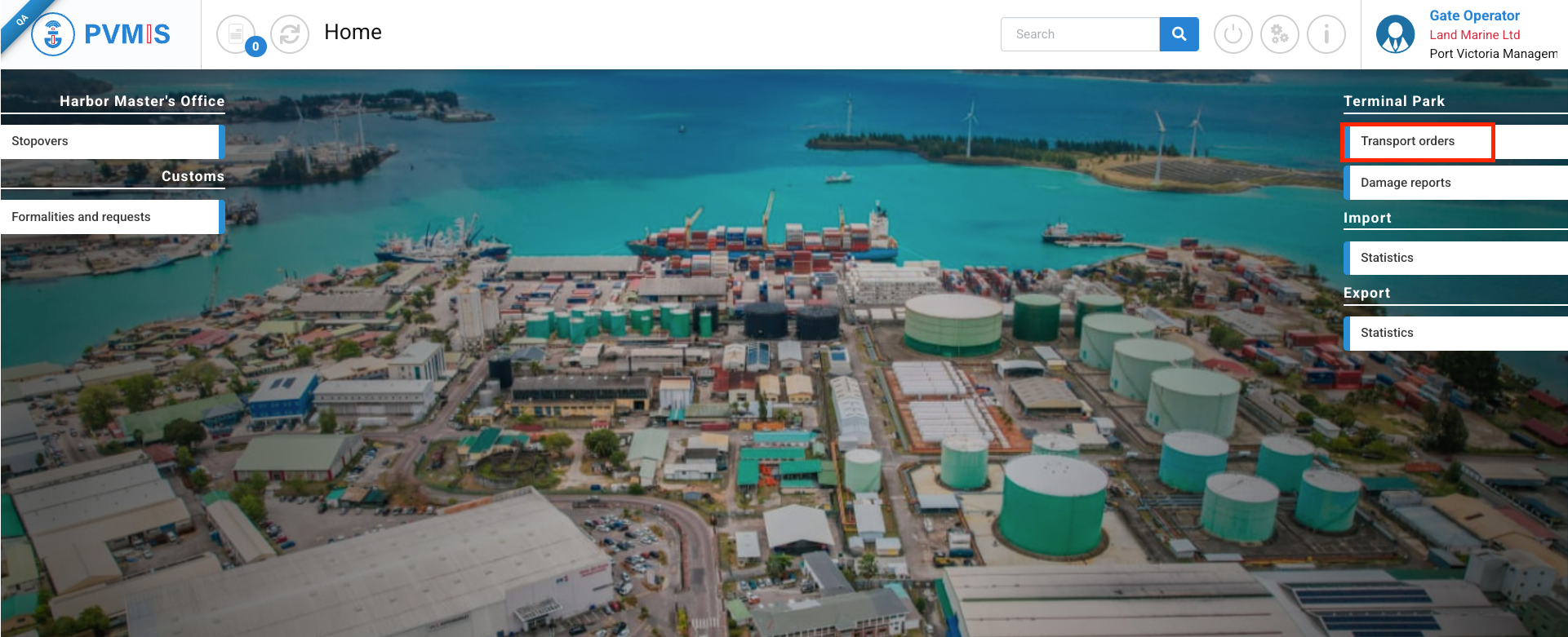
The user is redirected to the transport order list screen. The screen displays only the list of all transport orders.
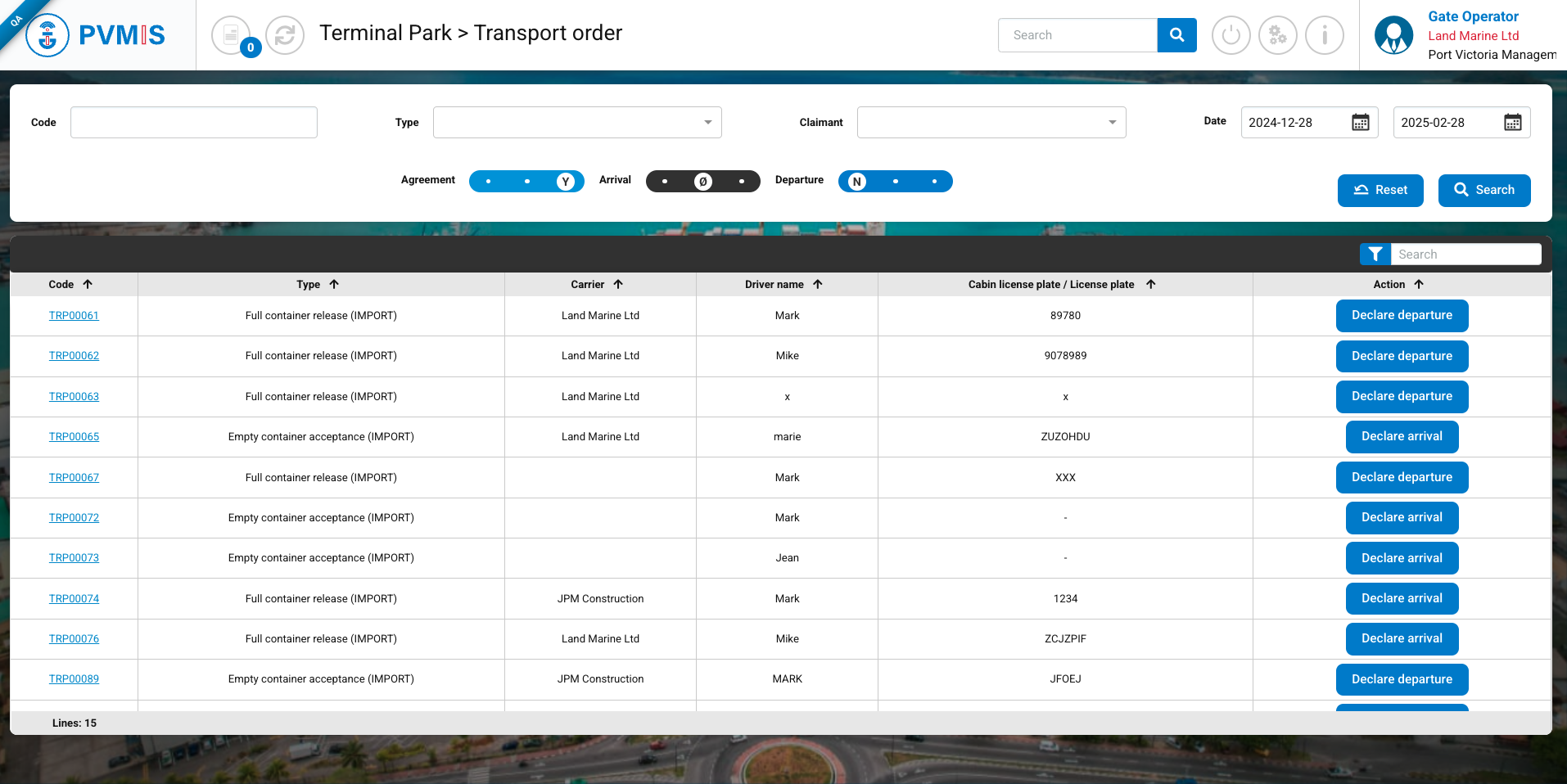
In the header, it’s possible to do a quick search by :
Code of transport order
Type of transport order (Empty container release (EXPORT), Full container acceptance (EXPORT), Full container release (IMPORT), Empty container acceptance (IMPORT)).
Date of the creation of the transport order
Freight forwarding company that created the transport order - Claimant : Allows filtering the list by freight forwarding company.
Status of the transport (Agreement ; Arrival ; Departure) and for each status select the state (No, No activated, Yes). By default, the status filters are configured to display the list of transport orders that are validated (Agreement status in YES). In order to prioritize the transport orders for which they need to declare the arrival or departure, the system should display these orders prominently at the forefront.
In the results table, the following columns are displayed:
Code, which corresponds to the transport order number generated by the system upon creation (when clicking the link, the user will be redirected to the transport order details screen).
Type of transport order
Carrier, which corresponds to the name of your transport company.
Driver name
Cabin license plate / License plate of the driver
Action : In this column, action buttons can be displayed. When logged in as a Gate opérateur :
If the arrival declaration has not been made for a transport order, or if the Arrival status is PARTIAL because there has already been a partial quantity of exits, the Declare Arrival button will be displayed. When this button is clicked, the user will be taken directly to the arrival declaration form.
Similarly, if the departure declaration has not been made for a transport order, or if the Departure status is PARTIAL because there has already been a partial quantity of exits, and a transporter has already re-entered the terminal to retrieve the remaining quantity, the Declare Departure button will be displayed. When this button is clicked, the user will be taken directly to the departure declaration form.
You can also access these forms from the transport order details screen. From the transport order list screen, simply click on the link of a transport order in the "Code" column.
On the transport order details screen, you can view the information and download the mission order by clicking the Download transport order button.
To declare the departure of the carrier, click on the Departure status.
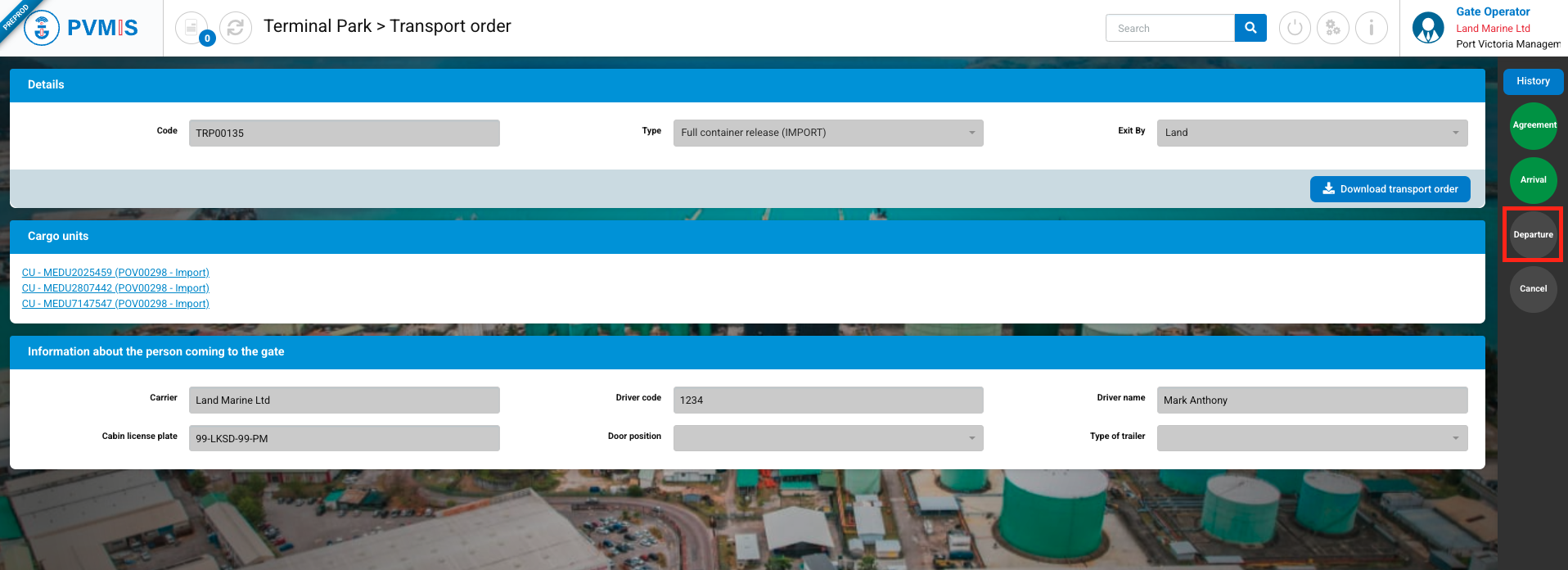
Click on Declare departure button:
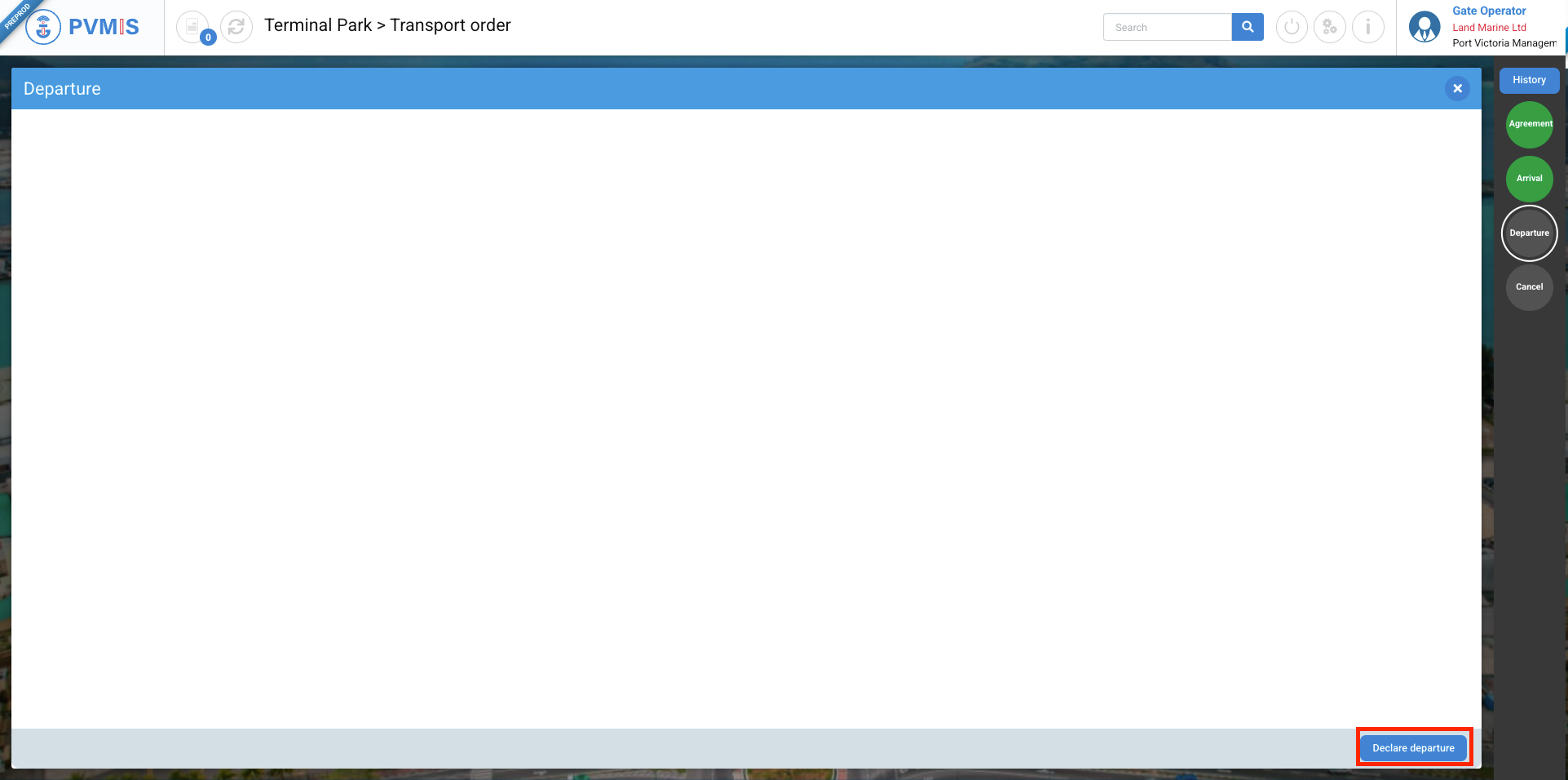
On the Departure Declaration form, the list of all Cargo Units included in the transport order is displayed. For each Cargo Unit, the following details are provided:
Cargo Unit code
Cargo Unit Type : Container, Bulk, Conventional, Vehicle
Initial quantity:
For a Container, the total number of packages it contains
For Bulk or Conventional, the quantity in kilograms
For a Vehicle, the total quantity per unit
Quantity already released: The quantity, based on the Cargo Unit type, that has already exited the terminal
Quantity released: The quantity, based on the Cargo Unit type, that is about to exit the terminal.
In the Quantity Released column, the default value displayed is 0. It is the Gate Operator's responsibility to manually enter the exact quantity of packages, kilograms, or units that are about to exit the terminal.

There are several ways to remove the goods from the terminal.
Exit of a full Cargo Unit
Partial exit goods
Exit of a full Cargo Unit
On a transport order with a single Cargo Unit indicated, this concerns the direct exit of that same full Cargo Unit from the terminal.
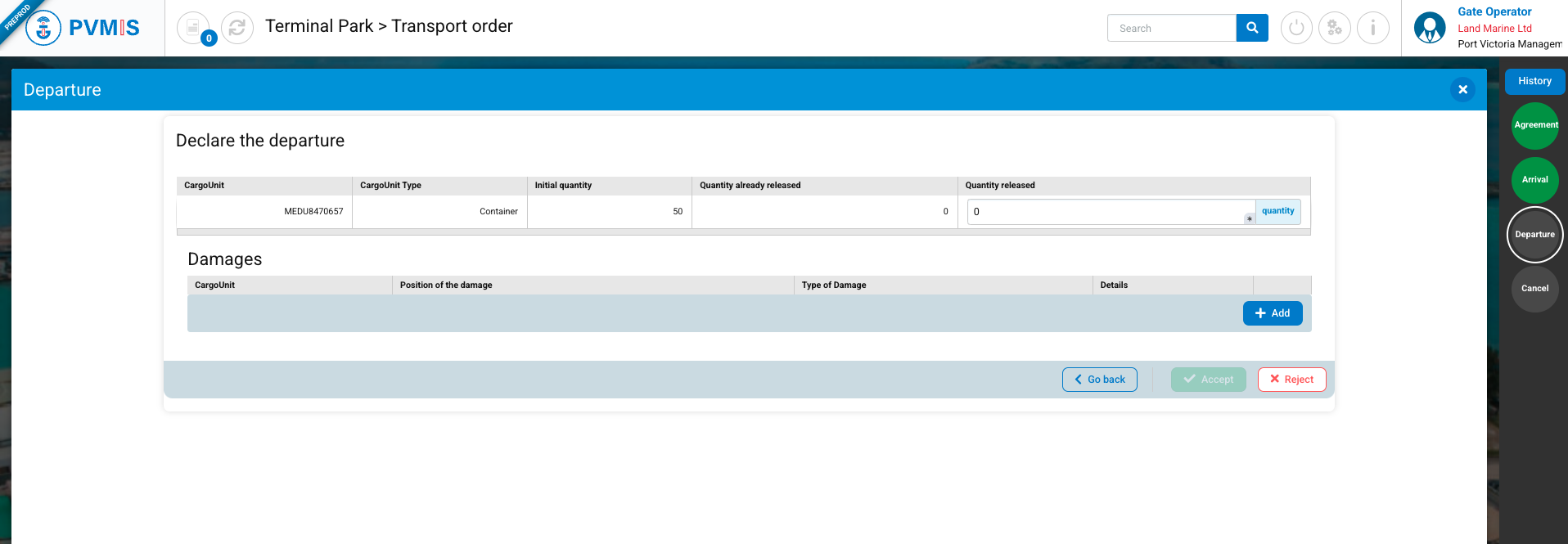
On the departure declaration form for a container transport order with a Cargo Unit of type container, the "Initial quantity" column displays the value "50," which corresponds to the total number of packages within the container. To declare the full exit of the container from the terminal, the Gate Operator must then manually enter the entire number of packages that have exited the container in the "Quantity released" column.
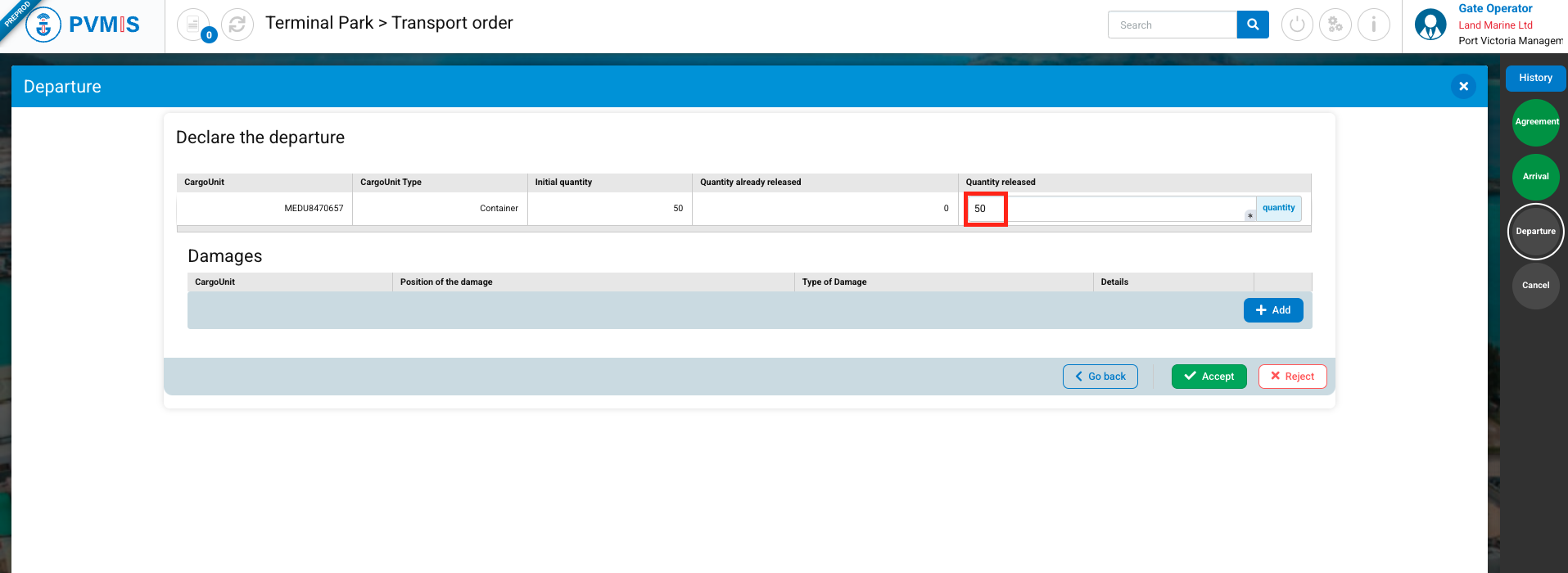
For a transport order with a Cargo Unit of type Bulk or Conventional, the Gate Operator must manually enter the total quantity in kilograms.
For a transport order with a Cargo Unit of type Vehicle, the Gate Operator must manually enter the total quantity of vehicles that have exited.
Click on the Accept button:

The user is redirected to the transport order detail screen.
The Departure status is in the "YES" state, which means that the total quantity of the transport order has exited the terminal.
Click on the Departure status :
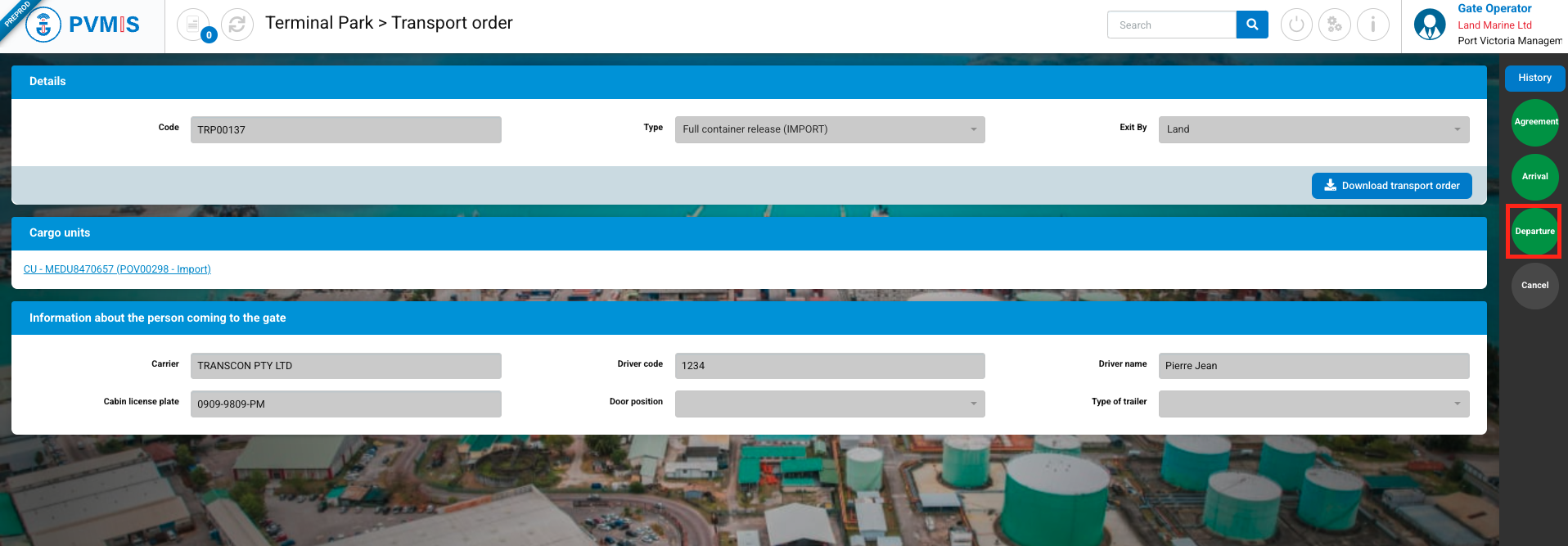
On the Departure status detail screen, we can see that in the "Releasable quantity left" column, the value displayed is 0, which means that all the goods have exited.
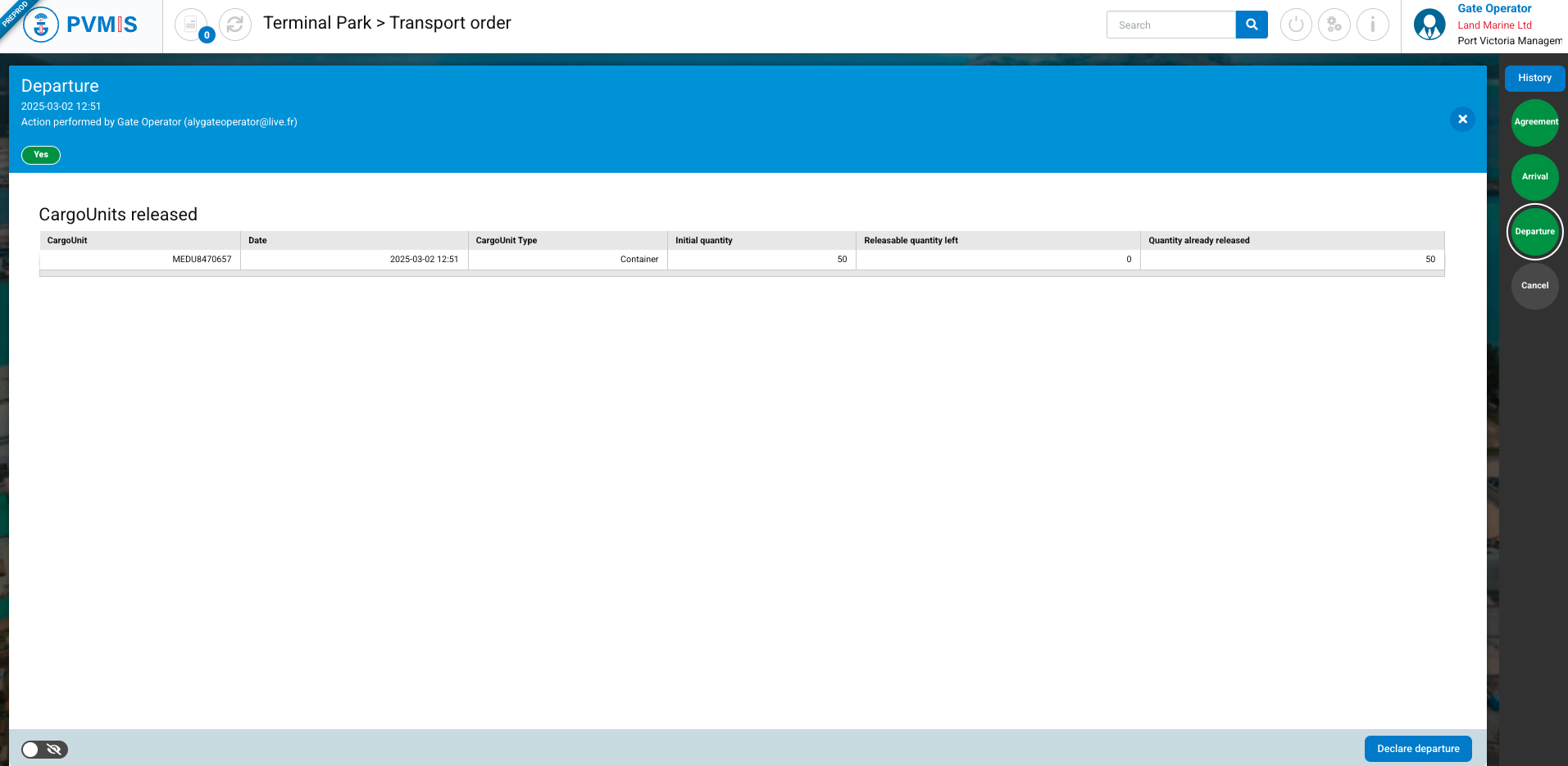
Partial exit goods
There are different types of partial exit management, which are handled by the Gate operator role during the arrival (Arrival status) or departure (Departure status) declaration, depending on the type of transport order.
For a transport order of the type Full Container Acceptance (IMPORT) for one or multiple Cargo Units, where packages have been removed from the Cargo Units in order to exit a partial quantity of packages, the Gate Operator can indicate on the departure declaration form that only 10 out of 100 packages have been exited from the terminal (for a Container type).
For Bulk or Conventional cargo, the quantity is recorded in kilograms, and for a Vehicle, the total quantity is recorded per unit. Similarly, for a container type, you can manage partial exits with different units.

For a transport order of the type Full Container Acceptance (IMPORT) for multiple Cargo Units that will be exited individually, one by one, with their total quantity (for example, for a container, the packages will not be removed from their contents), the Gate Operator can indicate on the departure declaration form that only 1 out of 3 Cargo Units has exited the terminal (for a Container type). They can also indicate the partial exit of packages from the Cargo Units.
For Bulk or Conventional cargo, the quantity is recorded in kilograms, and for a Vehicle, the total quantity is recorded per unit. Similarly, for a container type, you can manage partial exits with different units.

Management of partial exit for one or multiple Cargo Units, where packages have been removed to exit a partial quantity of packages
For this documentation, we will take the example of a container transport order with a single Cargo Unit, but this does not change the fact that the process is the same as if there were multiple Cargo Units.
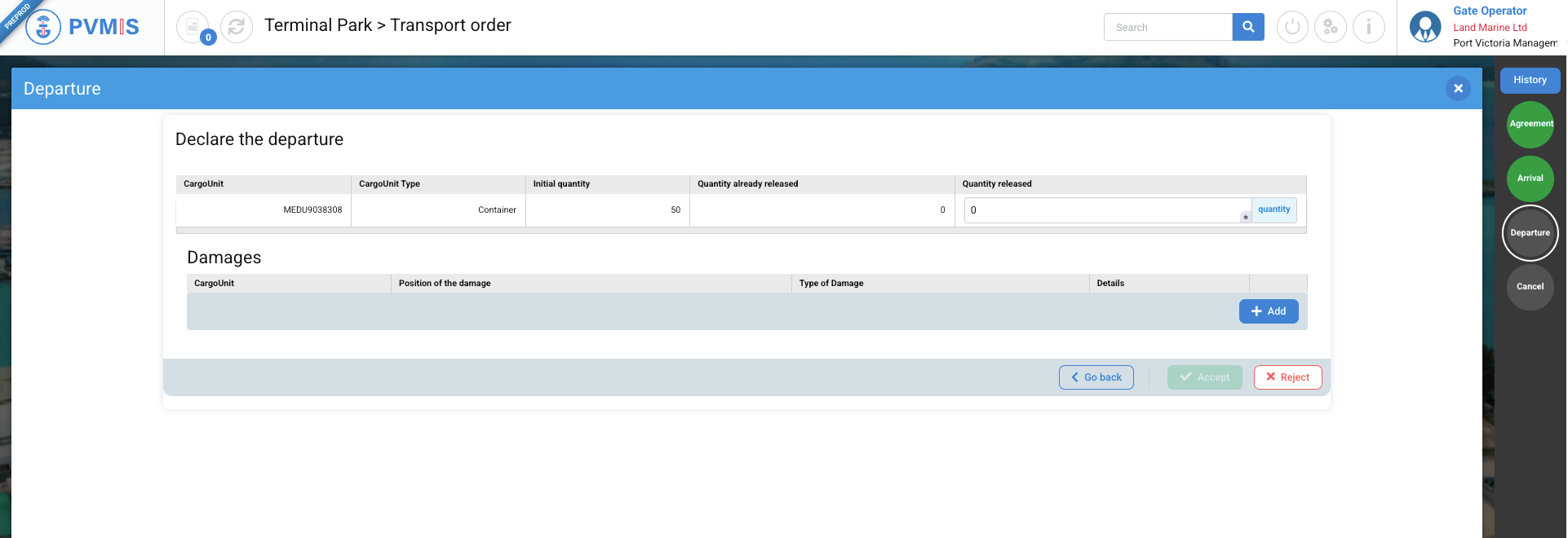
In the case of a partial quantity exit of a Cargo Unit that has been removed from its container, as a Gate operator on the departure declaration form, you will notice that in the "Initial Quantity" column, the value "50" appears, corresponding to the total number of packages the Cargo Unit was carrying. To indicate that only 20 out of the 50 packages are leaving the terminal, you must manually enter "20" in the "Quantity Release" column.
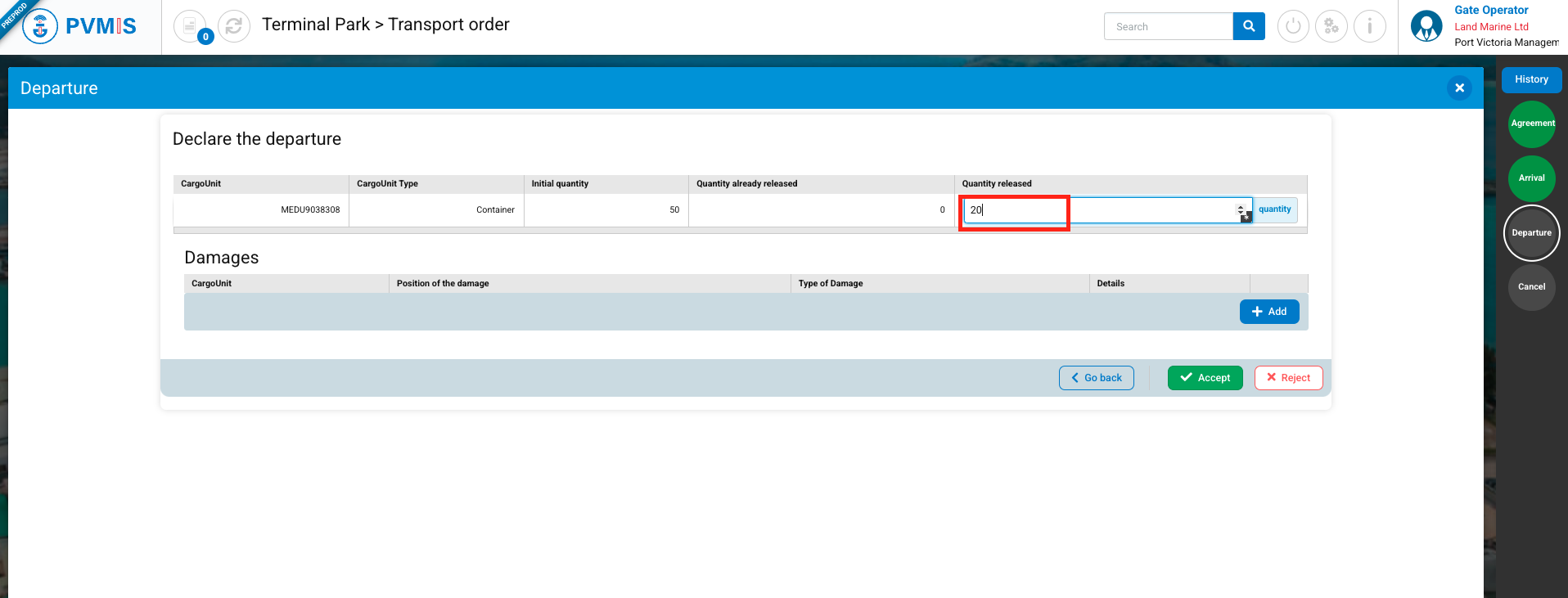
For a transport order with a Cargo Unit of type Bulk or Conventional, the Gate Operator must manually enter the exact quantity in kilograms at the point of exit.
For a transport order with a Cargo Unit of type Vehicle, the Gate Operator must manually enter the exact quantity of vehicles at the point of exit.
To validate the form, in the "Quantity Release" column, you cannot enter a quantity that is less than or greater than the initial quantity.
Click on the Accept button:
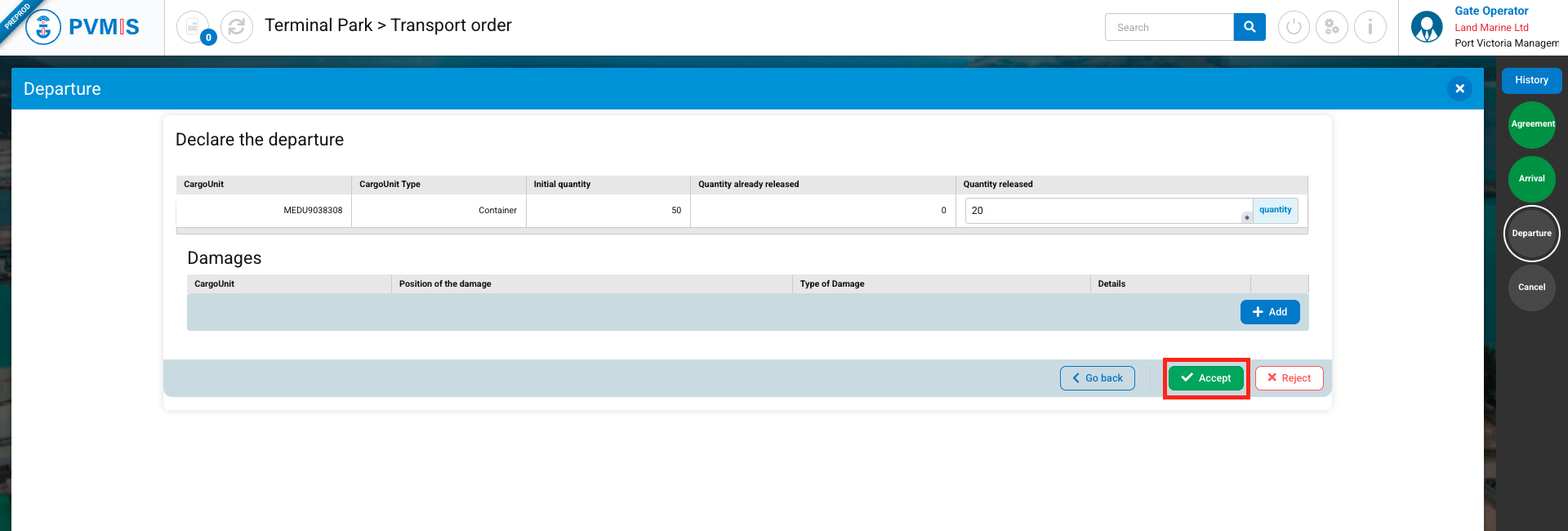
The user is redirected to the transport order detail screen. The Arrival and Departure status are in the "PARTIAL" state, which means that the total quantity of goods for the transport order has not left the terminal, and the carrier will return to collect the remaining quantity.
Therefore, as a Gate Operator, when the carrier must present themselves at the gate with the same transport order, you will need to declare the arrival.
Click on the Arrival status to declare the arrival of the carrier returning to the terminal, you will need to register the arrival in the system, ensuring that the transport order is updated to reflect the return of the remaining goods.
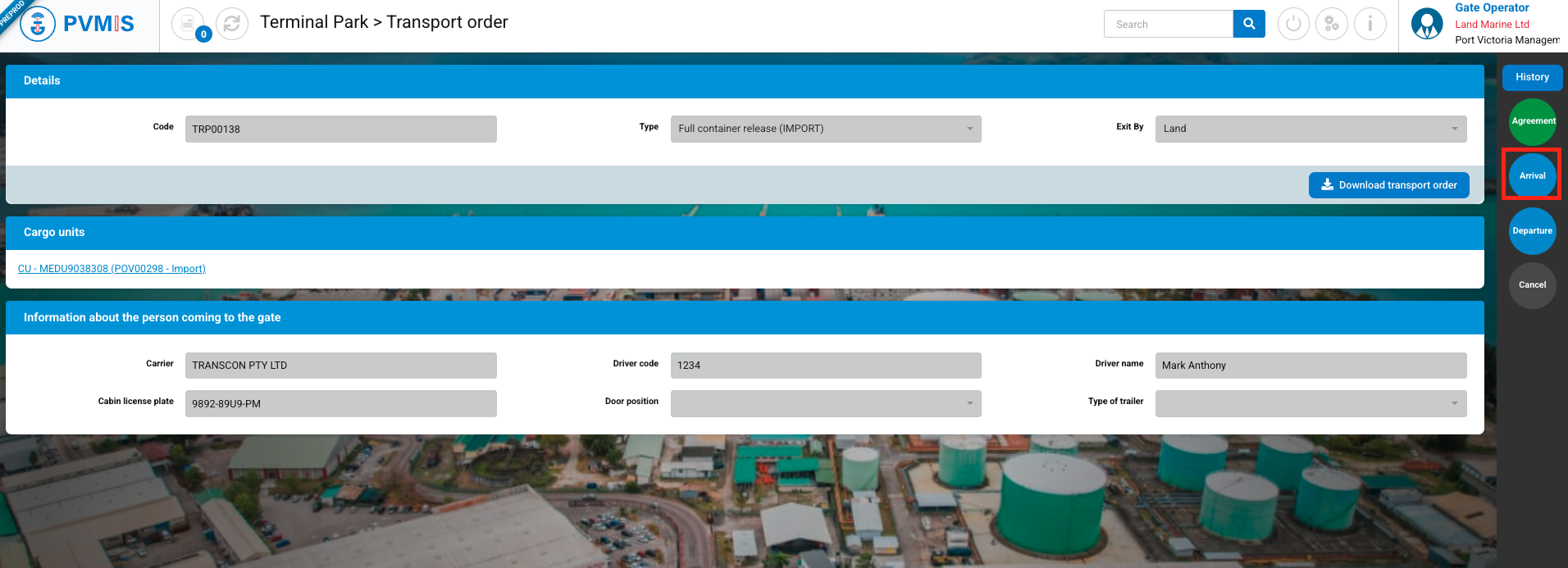
On the Arrival status detail screen, you can view the carrier's information that was recorded during their first pass. Click on Declare arrival button:
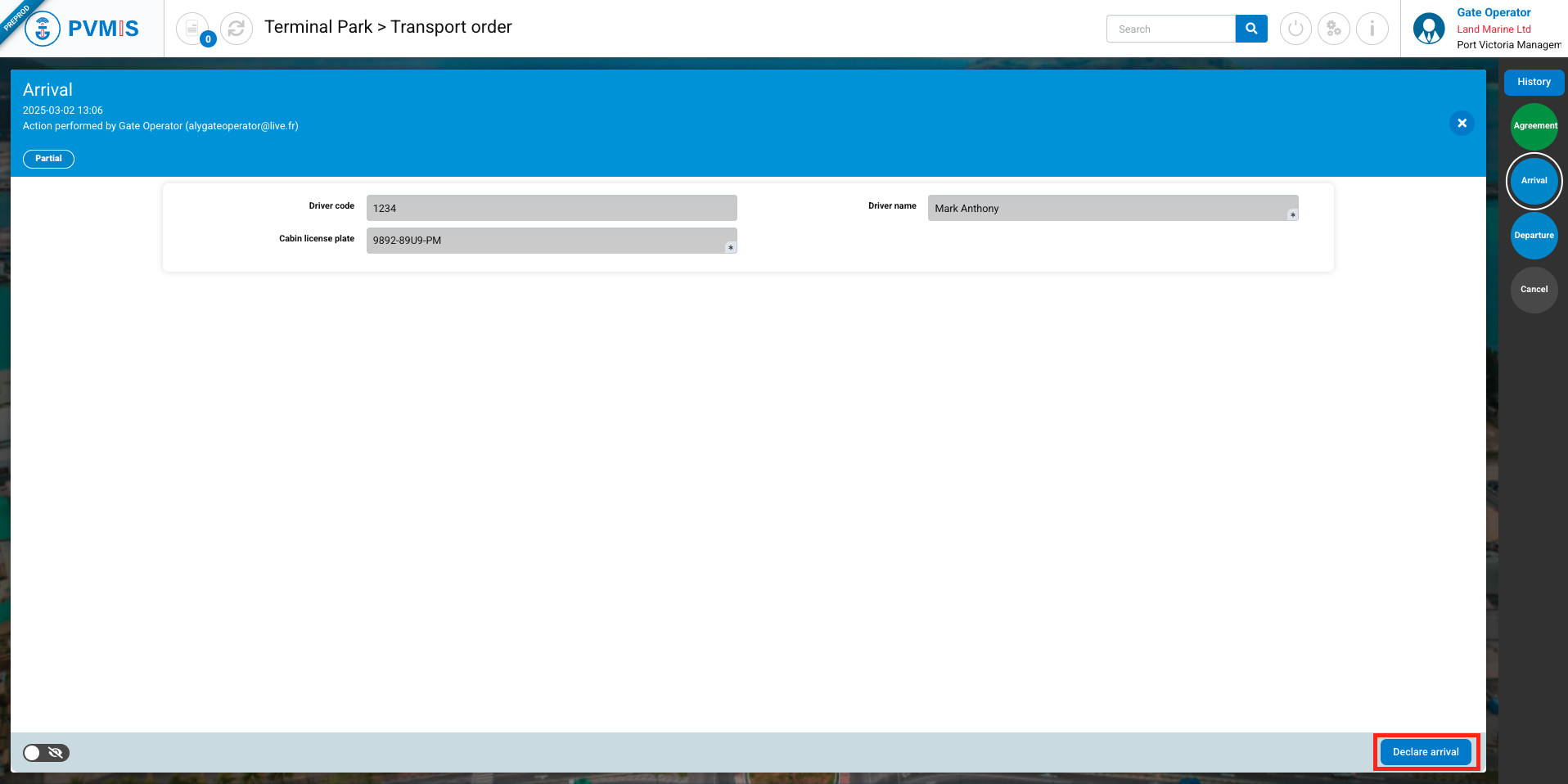
Click on Accept button:

In the case where the carrier has changed and is not the same person as during the first pass, as a Gate Operator, you can modify this information (Driver code, Driver name, Cabin license plate), and it is your responsibility to validate this change. You can view the carrier history for each visit to the terminal by clicking on the toggle on the left.
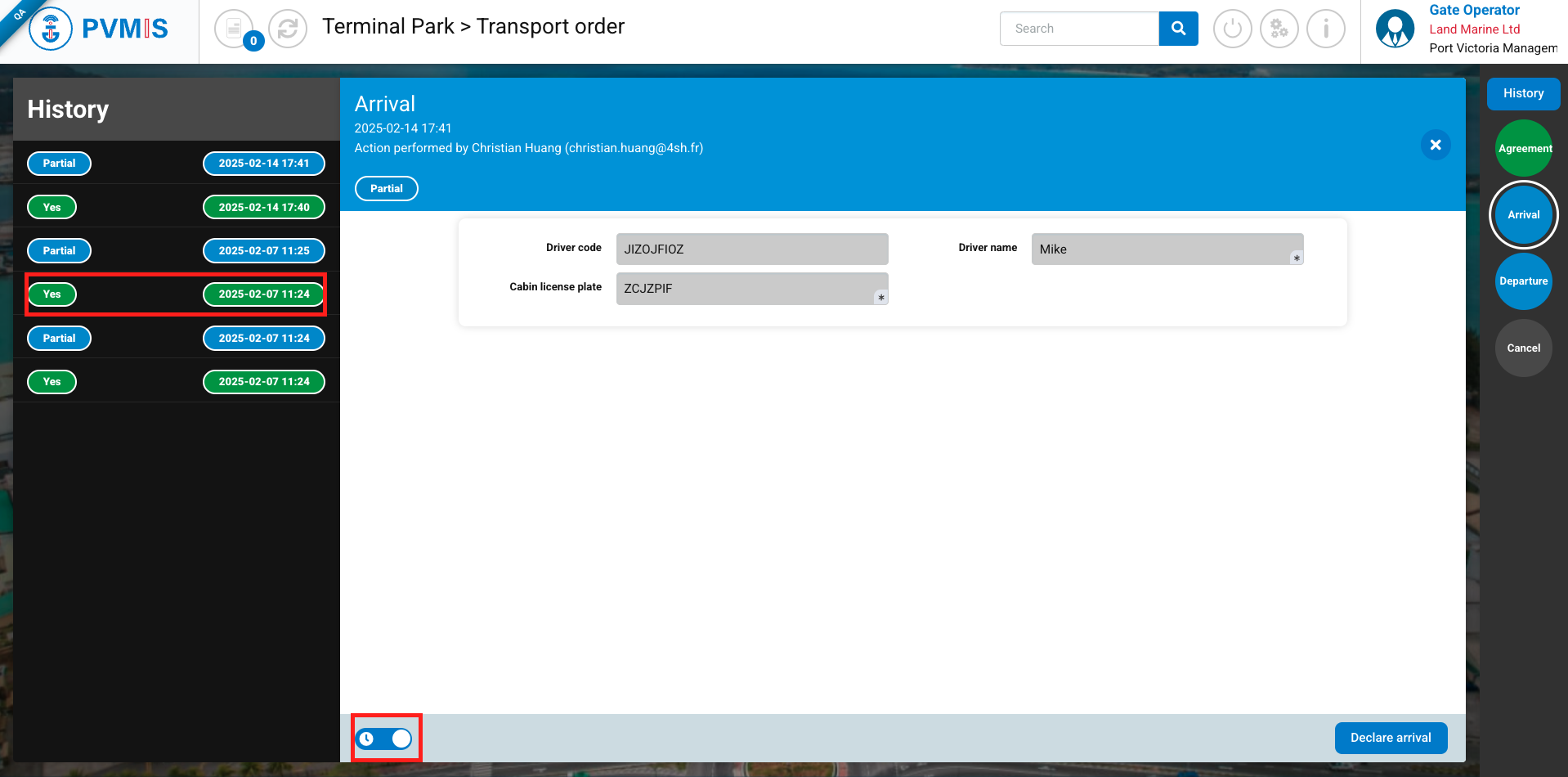
The user is redirected to the transport order detail screen, and the Arrival status is set to "YES."
Click on the Departure status:
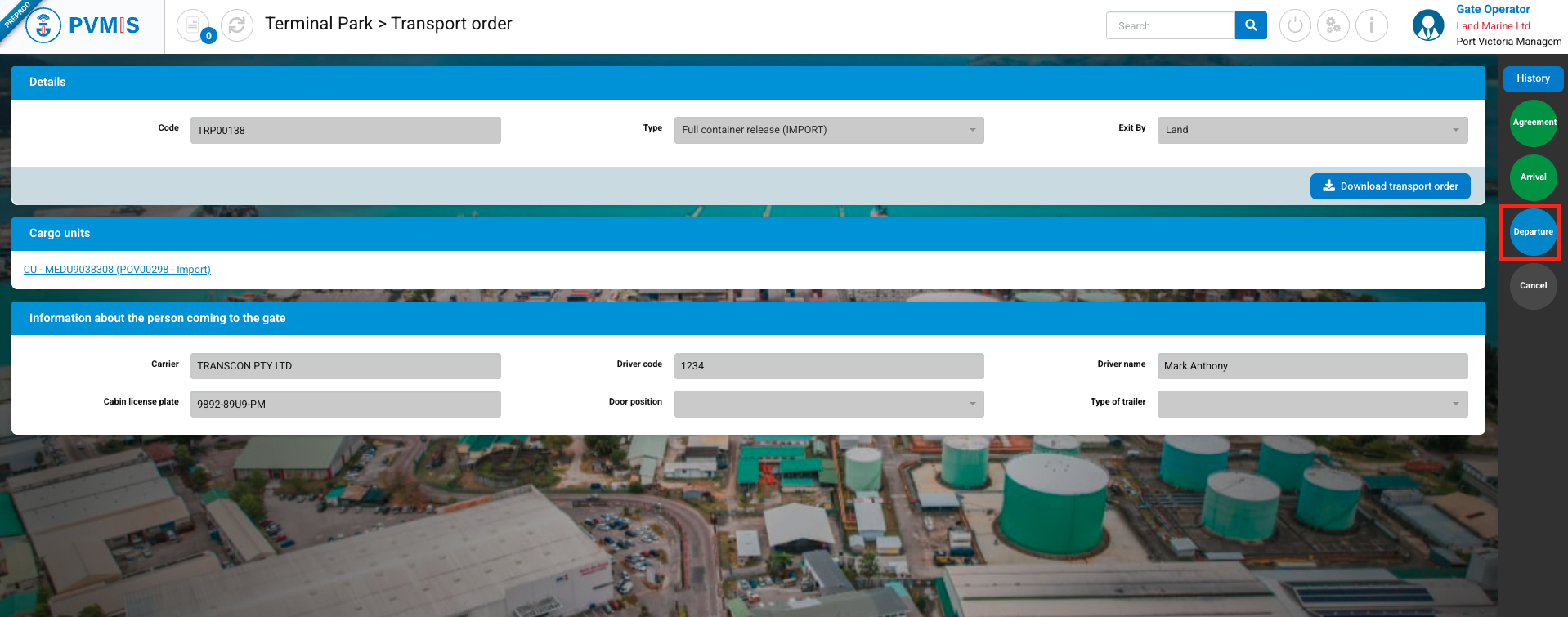
In the Departure status detail, you can see that there are still 30 packages remaining on the terminal and 20 packages already delivered.
Click on the Declare departure button:
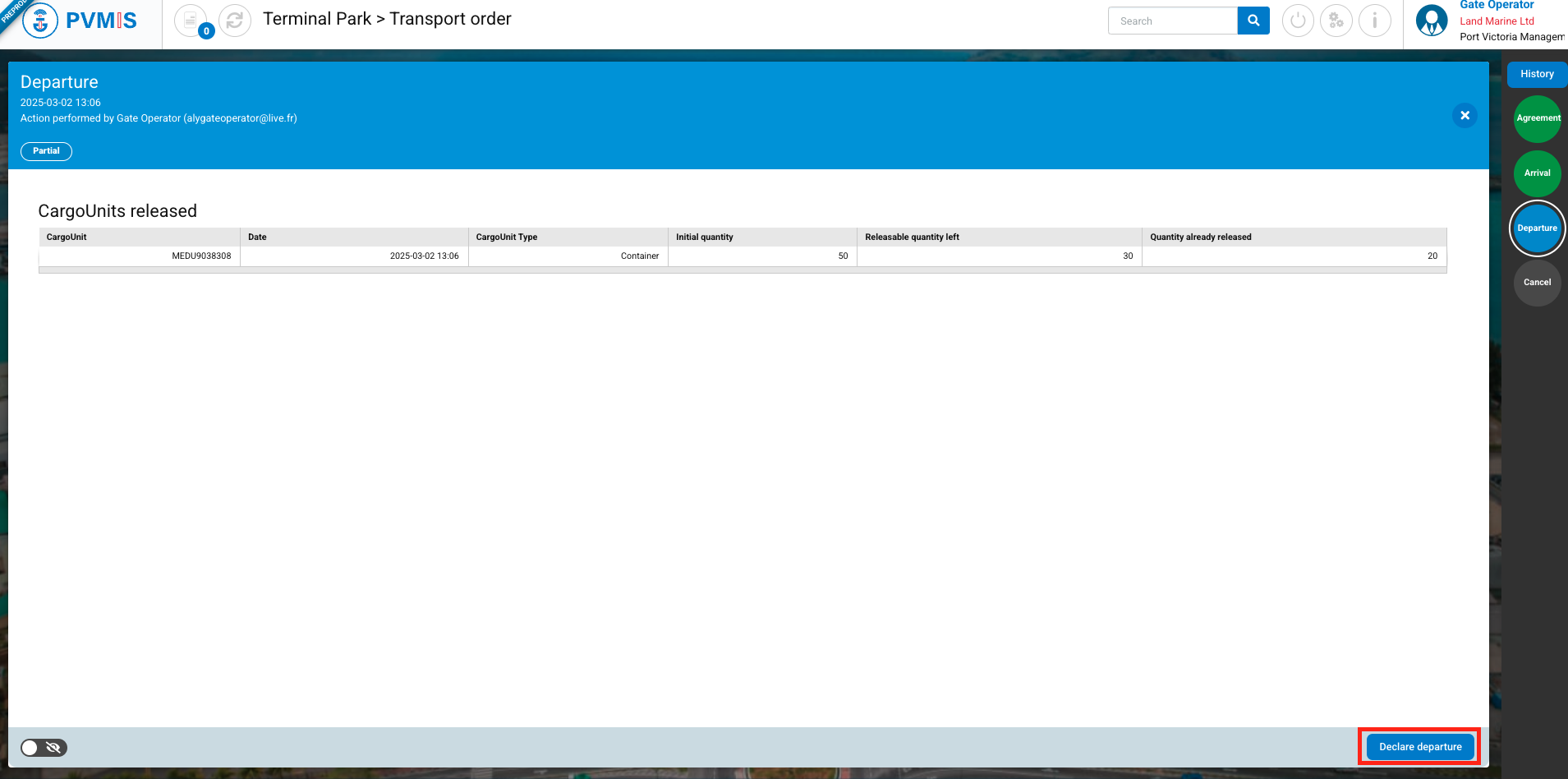
On the departure declaration form, you can either indicate a partial quantity to be released again in the "Quantity Released" column (for example, 10 packages out of the remaining 20). In this case, the carrier will need to return to the terminal, and you will repeat the actions described above. If you enter the remaining total quantity to be released (20 packages), the carrier will have completed their mission.
Manually complete the remaining total quantity to be released (the difference between the initial quantity and the quantity already released), then click on the Accept button:
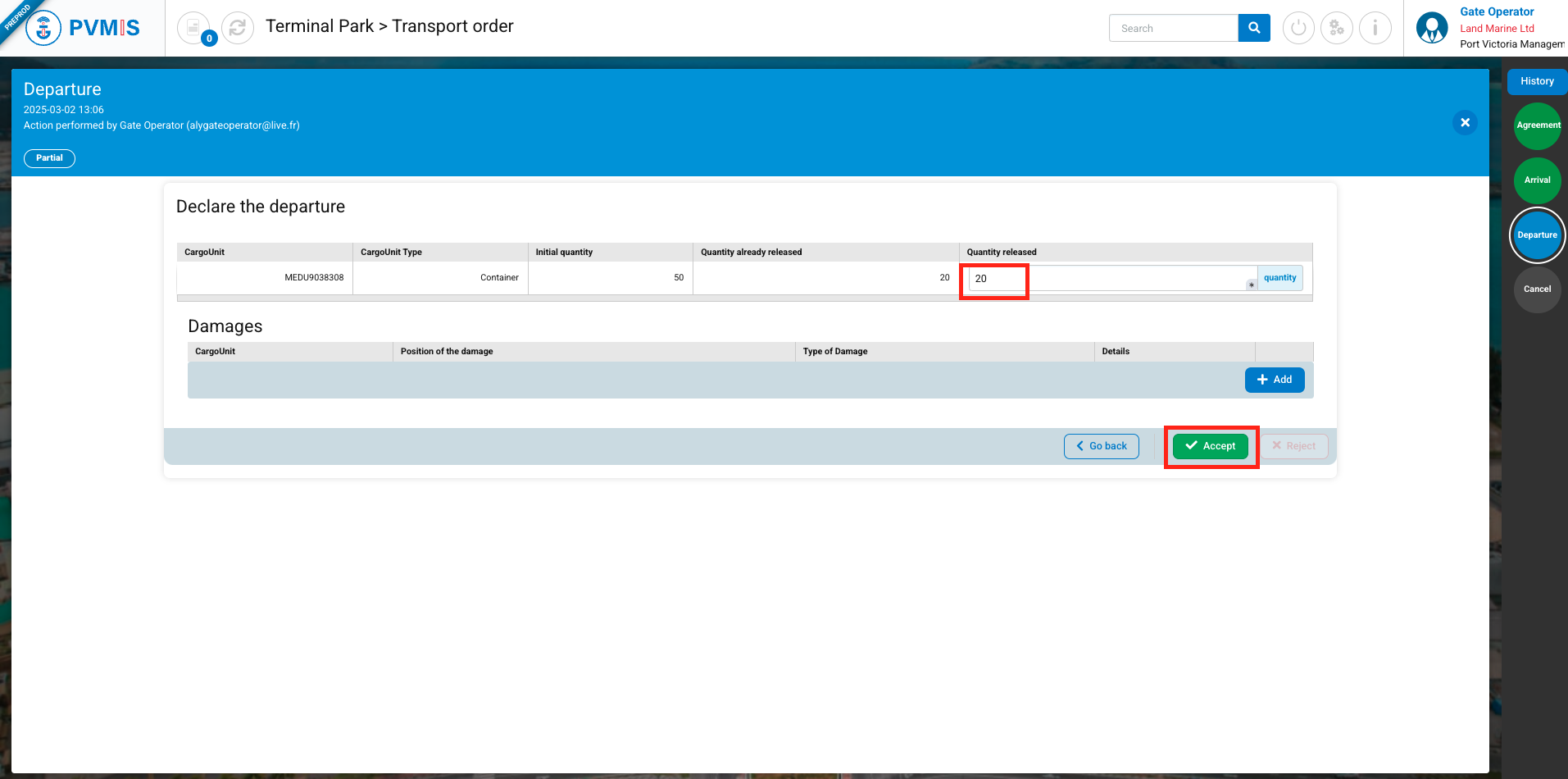
The Arrival and Departure status are in the "YES" state, which means that the total quantity of the transport order has exited the terminal.
Management of partial exit for a multiple Cargo Units that will be exited individually
For a transport order with multiple Cargo Units, where the carrier will make several round trips to the terminal to collect one full Cargo Unit per trip, it is sufficient to enter the total quantity to be released per Cargo Unit for each departure declaration.

From the list, select the Cargo Unit to be released, and manually enter the total quantity (Initial quantity) in the "Quantity Released" column.
For a transport order with Cargo Units of type Bulk or Conventional, the Gate Operator must manually enter the total quantity in kilograms.
For a transport order with Cargo Units of type Vehicle, the Gate Operator must manually enter the total quantity of vehicles that have exited.
Click on the Accept button:
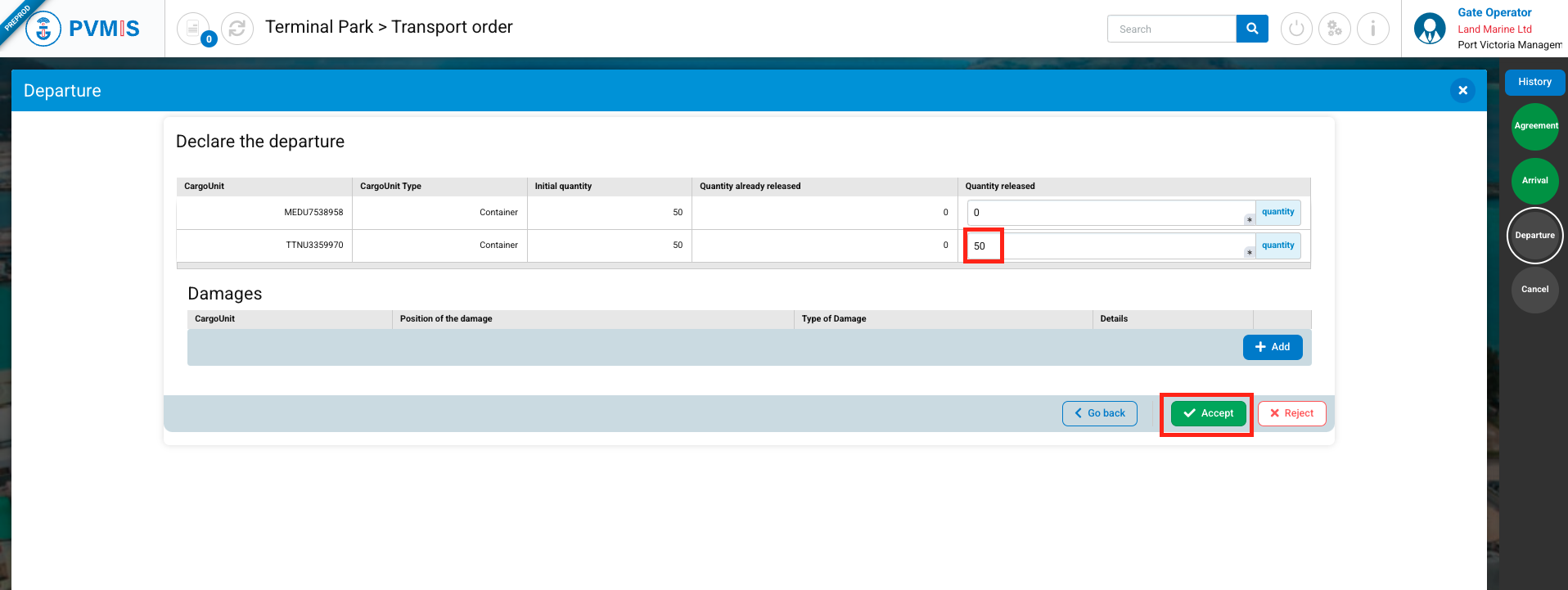
The user is redirected to the transport order detail screen. The Arrival and Departure status are in the "PARTIAL" state, which means that the total quantity of goods for the transport order has not left the terminal, and the carrier will return to collect the remaining quantity.
Therefore, as a Gate Operator, when the carrier must present themselves at the gate with the same transport order, you will need to declare the arrival.
Click on the Arrival status to declare the arrival of the carrier returning to the terminal, you will need to register the arrival in the system, ensuring that the transport order is updated to reflect the return of the remaining goods.
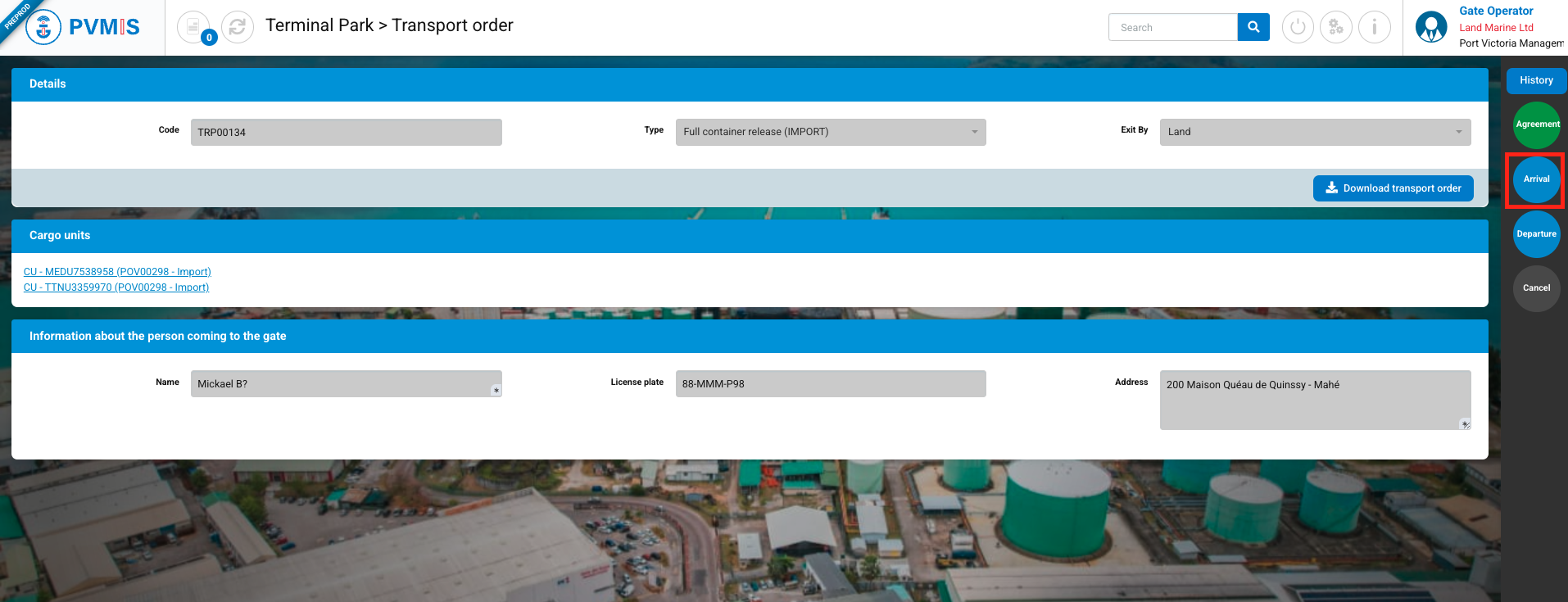
On the Arrival status detail screen, you can view the carrier's information that was recorded during their first pass. Click on Declare arrival button:
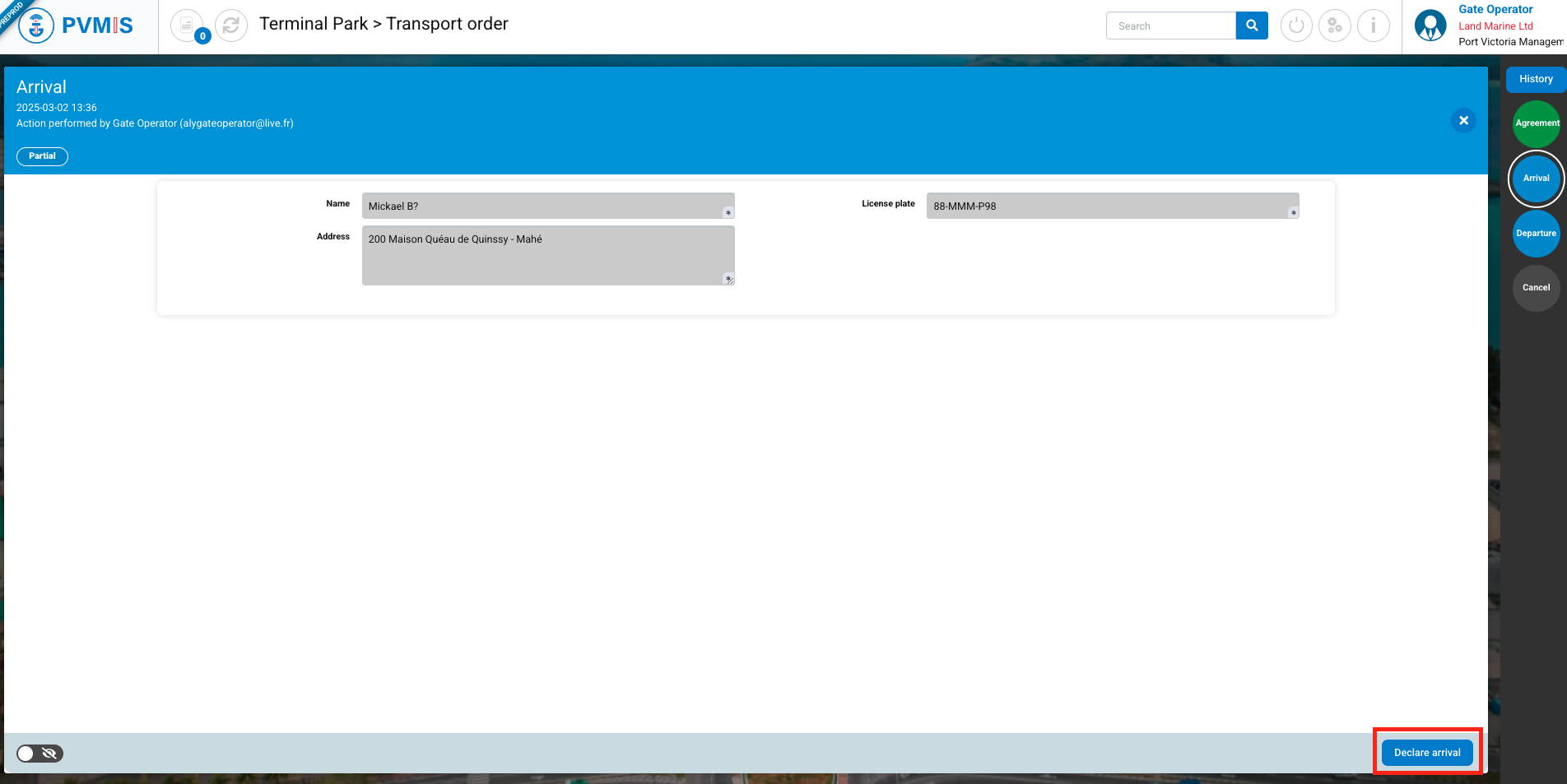
Click on Accept button:

In the case where the carrier has changed and is not the same person as during the first pass, as a Gate Operator, you can modify this information (Driver code, Driver name, Cabin license plate), and it is your responsibility to validate this change. You can view the carrier history for each visit to the terminal by clicking on the toggle on the left.

The user is redirected to the transport order detail screen, and the Arrival status is set to "YES."
Click on the Departure status:
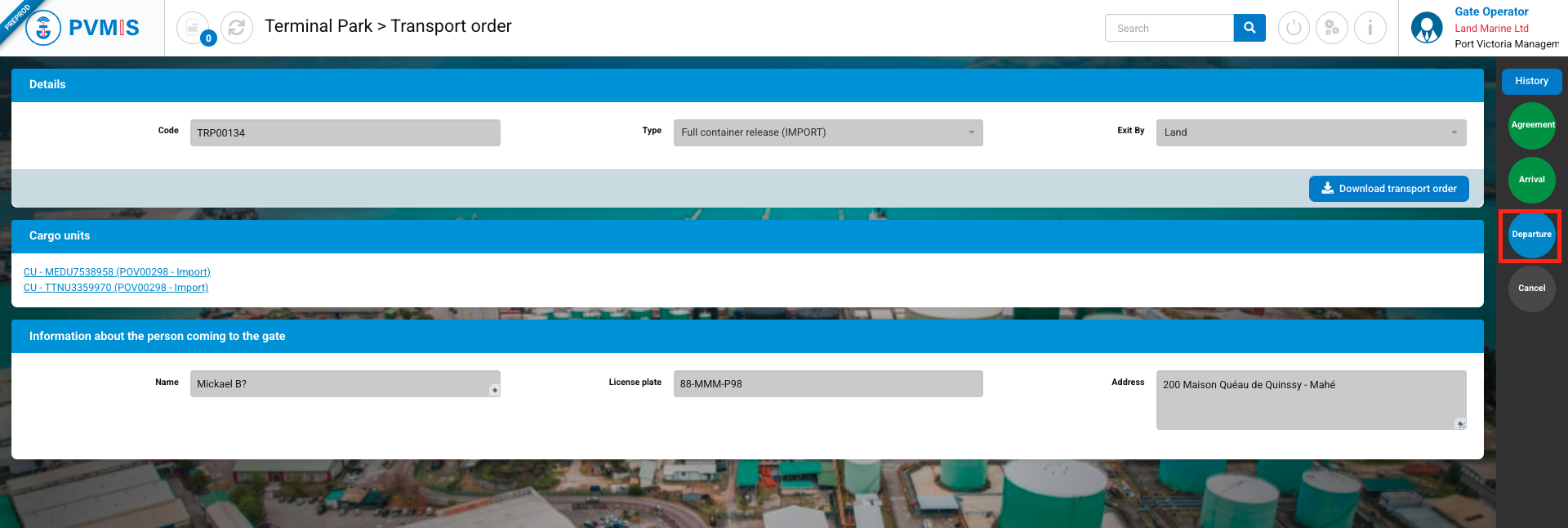
On the detail of the Departure status screen, you can see that for the Cargo Unit already exited from the terminal, the remaining quantity to be released is 0 (Releasable quantity left), and for the other Cargo Unit that hasn't exited, no quantity has been released yet (Quantity already released).
Click on the Declare departure button:
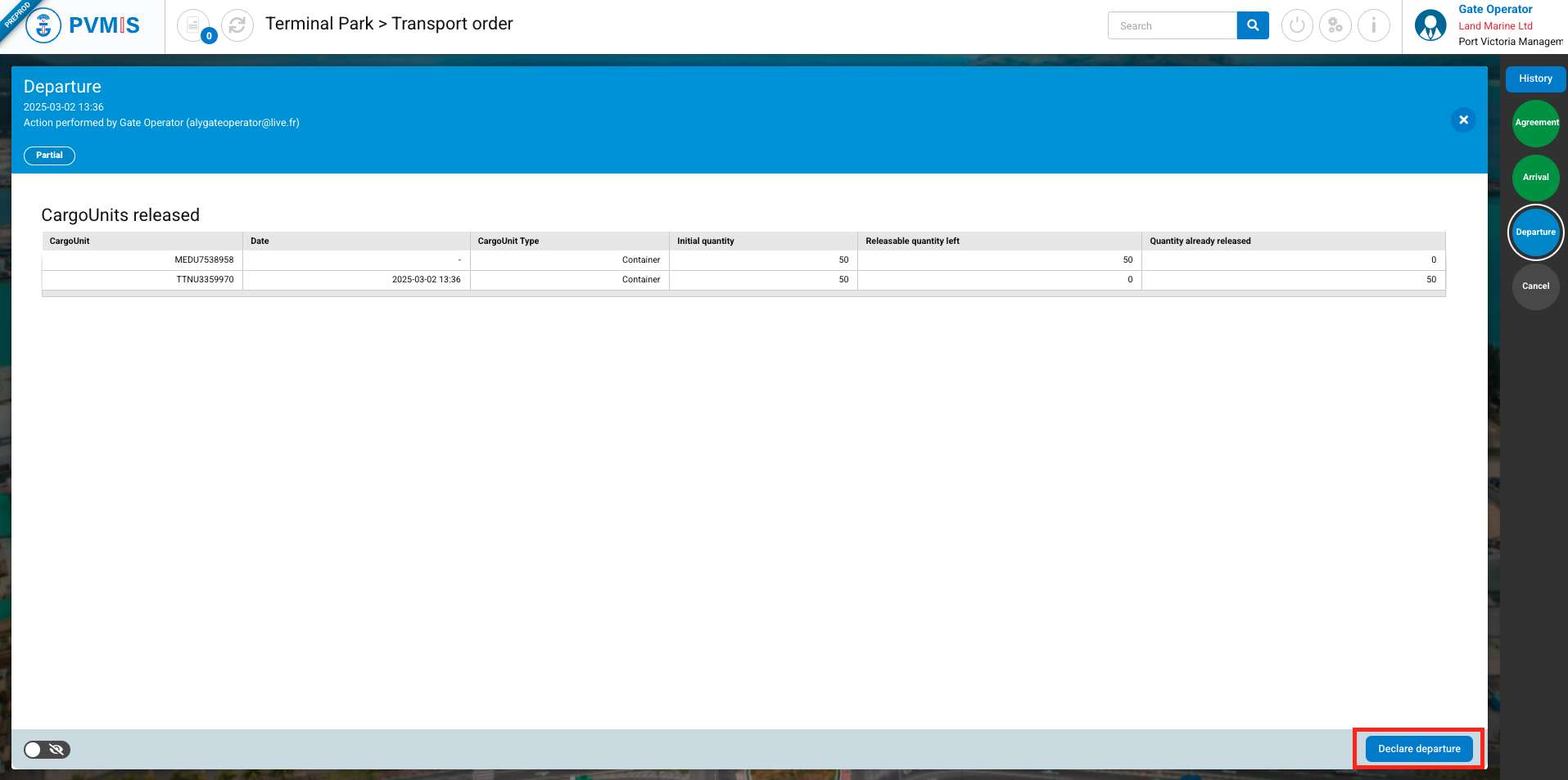
On the line for the Cargo Unit that has already exited, there is no action to be taken. You only need to manually enter the total quantity (Initial quantity) of the next full Cargo Unit to be released.
Then click on the Accept button:
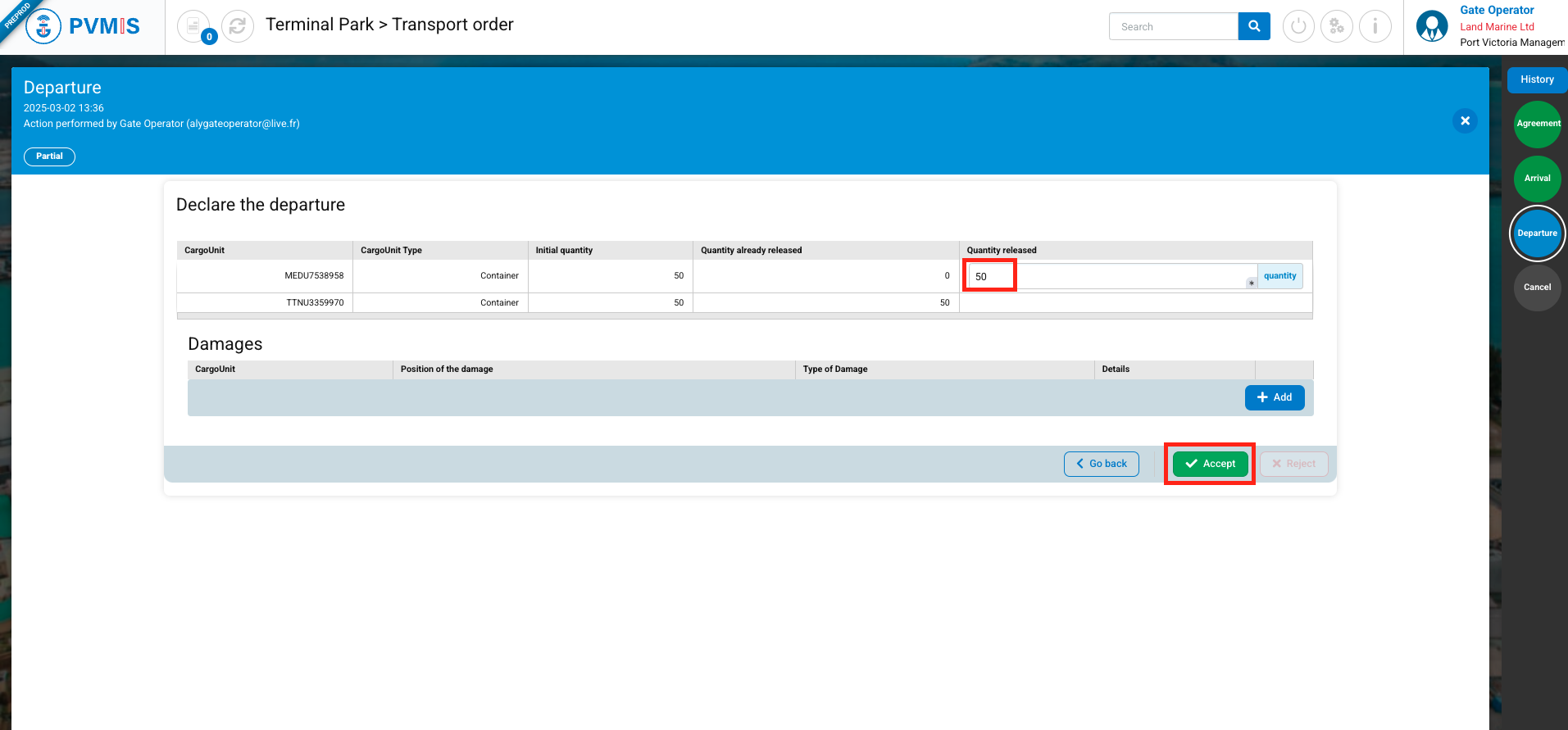
The Arrival and Departure status are in the "YES" state, which means that the total quantity of the transport order has exited the terminal.
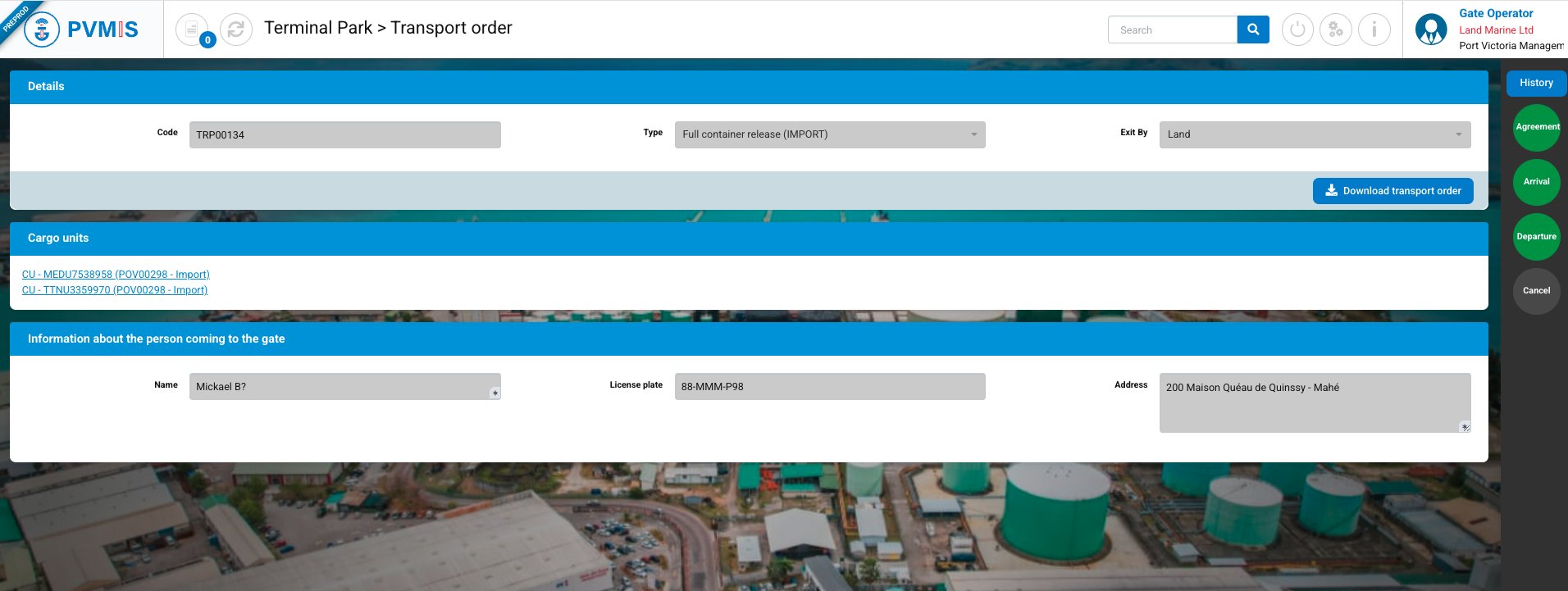
Damages report
As a Gate Operator, for each departure declaration, you have the option to provide an anomaly report for a specific Cargo Unit.
On the departure form click on +Add button:
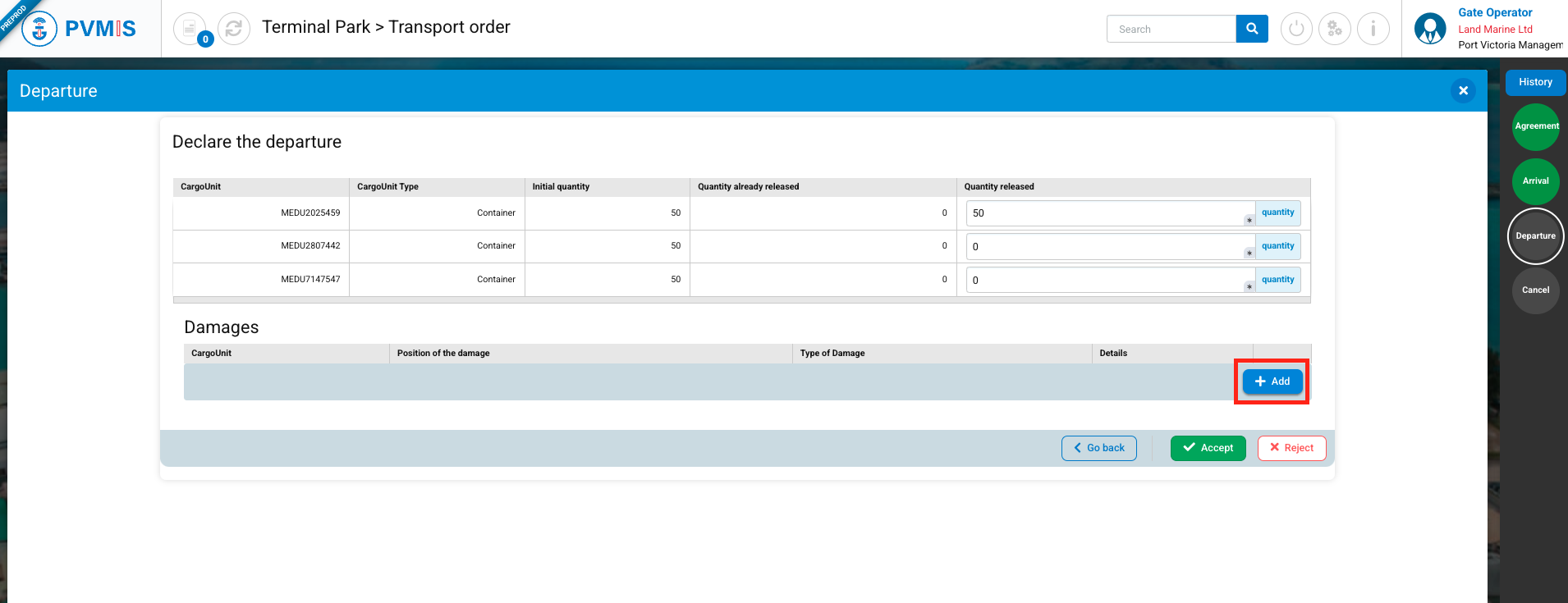
A line is generated for each anomaly, and each added line corresponds to a specific type of anomaly in a targeted location on a Cargo Unit. If you detect multiple anomalies on a Cargo Unit, you should add a line for each type. If you detect the same anomaly but at different locations on a Cargo Unit, you should add a line for each position.
To save an anomaly report, it is mandatory to select a Cargo Unit (Cargo Unit column), the position of the anomaly, and the type of anomaly.
You can also optionally add additional information in the "Details" column.
To delete an anomaly report, click on the trash bin icon.
After indicating the quantity to be released from the terminal and completing the mandatory information to save your damage reports, click on the Accept button:

After validating the departure form, you can find all your damage reports in the "Damage Report" menu under the "Terminal Park" section.

In this list, click on the link of a damage report in the "Code" column to access on the detail.

On the damage report detail screen, you will find all the entered information.
